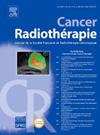Four-dimensional computed tomography scan-based evaluation of intrinsic lung tumour motion and hysteresis using tumour centroid: Implication towards high-precision radiotherapy for lung cancer
IF 1.4
4区 医学
Q4 ONCOLOGY
引用次数: 0
Abstract
Purpose
Predicting the target position accurately based on an external surrogate with quantifiable correlation is important for high-precision radiation in lung cancer. This study aimed to quantify the amount of movement of the lung tumours and understand the pattern of hysteresis based on four-dimensional (4D) computed tomography (CT) imaging compared to the chest wall movement.
Materials and methods
From the radiotherapy four-dimensional computed tomography (4DCT) scan images, a total of 43 lung tumours from 21 patients were contoured, and movement in mediolateral (X), anteroposterior (Z), and superoinferior (Y) directions were calculated based on tumour centroid of the smart breath cine mode of the 4DCT scan. The tumour motion in different phases of the breathing cycle was calculated, and the deformation of the shape was illustrated using a 3D slicer. The nonlinear trajectory of the tumour motion resulting in tumour hysteresis was computed.
Result
Tumour motion calculated from the 4DCT images in X, Z, and Y directions were 0.21 ± 0.22 (range: 0.01–1.20), 0.18 ± 0.15 (range: 0.01–0.49), 0.77 ± 0.33 (range: 0.24–1.80) respectively. The mean three-dimensional radial motion vector was 0.85 ± 0.31 (range: 0.21–1.81). No significant correlation between the magnitude of chest wall movement and three-dimensional radial vector was observed. Hysteresis in XZ plane was calculated to be 0.56 ± 0.61 cm2 (range: 0.01–3.03). A statistically significant difference in hysteresis was observed between central and peripheral tumours (0.19 ± 0.31 cm2 vs. 0.94 ± 0.63 cm2, P < 0.01).
Conclusion
4DCT-based tumour motion estimation is a feasible method, and the predictability of tumour motion by chest wall movement was not optimal. The movement was more for peripheral tumours compared to centrally located lesions. Location relative to midline was the most critical predictor of hysteresis. Considerable shape deformation in different phases of respiration was observed, and peripheral tumours had more than two times the motion during the breathing cycle compared to the central tumours.
基于肿瘤质心的四维计算机断层扫描评价肺内肿瘤运动和迟滞:对肺癌高精度放疗的意义
目的基于可量化相关性的外部替代物准确预测靶位对肺癌的高精度放疗具有重要意义。本研究旨在量化肺肿瘤的运动量,并了解基于四维(4D)计算机断层扫描(CT)成像与胸壁运动相比较的迟滞模式。材料与方法从放疗四维计算机断层扫描(4DCT)图像中,对21例患者共43个肺肿瘤进行轮廓化,并根据4DCT扫描智能呼吸电影模式的肿瘤质心计算肿瘤在中外侧(X)、正前方(Z)和上下(Y)方向的运动。计算了呼吸周期不同阶段的肿瘤运动,并使用3D切片机说明了形状的变形。计算了引起肿瘤迟滞的肿瘤运动的非线性轨迹。结果4DCT图像在X、Z、Y方向计算的肿瘤运动值分别为0.21±0.22(范围:0.01 ~ 1.20)、0.18±0.15(范围:0.01 ~ 0.49)、0.77±0.33(范围:0.24 ~ 1.80)。三维径向运动矢量平均值为0.85±0.31(范围:0.21 ~ 1.81)。胸壁运动幅度与三维径向矢量无明显相关性。XZ平面的迟滞量为0.56±0.61 cm2(范围:0.01 ~ 3.03)。中枢性肿瘤和外周性肿瘤的迟滞性差异有统计学意义(0.19±0.31 cm2比0.94±0.63 cm2, P <;0.01)。结论基于ct的肿瘤运动估计是一种可行的方法,但胸壁运动对肿瘤运动的预测不是最优的。与位于中心的病变相比,周围肿瘤的运动更多。相对于中线的位置是迟滞最关键的预测因子。在呼吸的不同阶段观察到相当大的形状变形,与中枢肿瘤相比,周围肿瘤在呼吸周期中的运动超过两倍。
本文章由计算机程序翻译,如有差异,请以英文原文为准。
求助全文
约1分钟内获得全文
求助全文
来源期刊

Cancer Radiotherapie
医学-核医学
CiteScore
2.20
自引率
23.10%
发文量
129
审稿时长
63 days
期刊介绍:
Cancer/radiothérapie se veut d''abord et avant tout un organe francophone de publication des travaux de recherche en radiothérapie. La revue a pour objectif de diffuser les informations majeures sur les travaux de recherche en cancérologie et tout ce qui touche de près ou de loin au traitement du cancer par les radiations : technologie, radiophysique, radiobiologie et radiothérapie clinique.
 求助内容:
求助内容: 应助结果提醒方式:
应助结果提醒方式:


